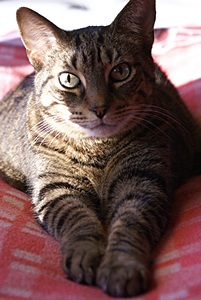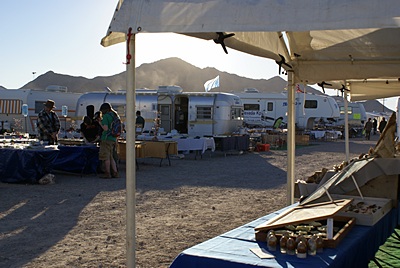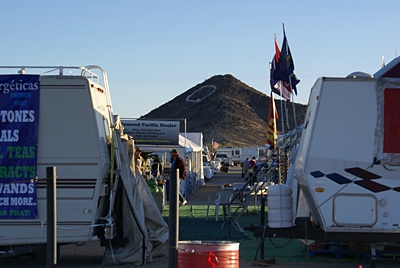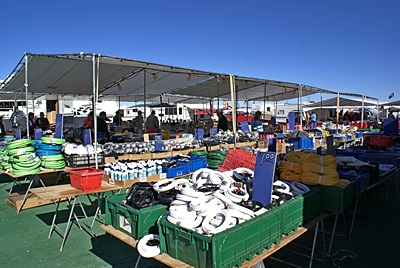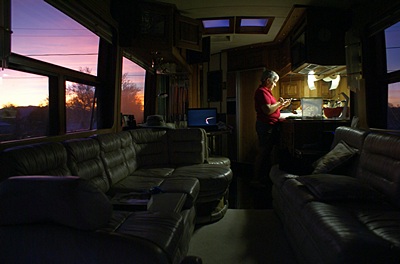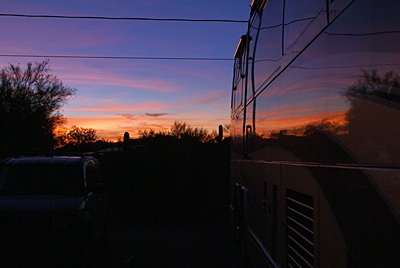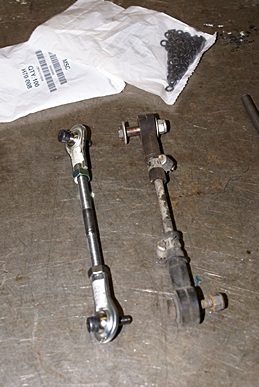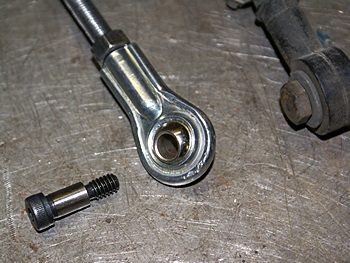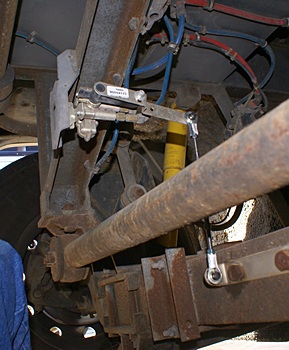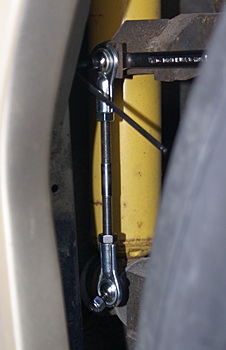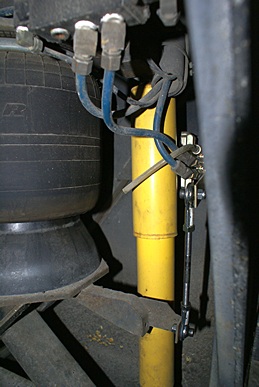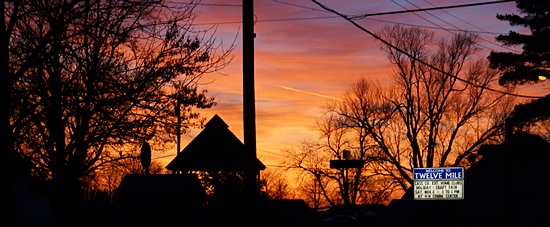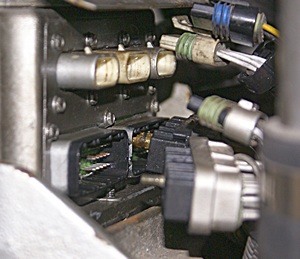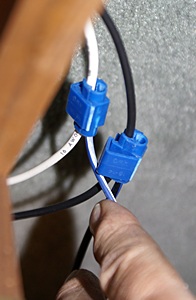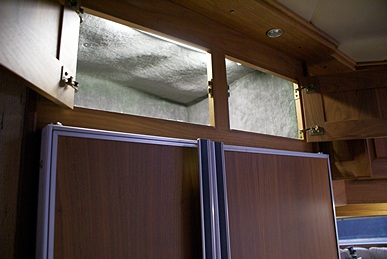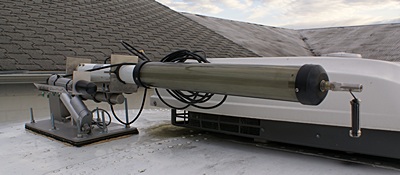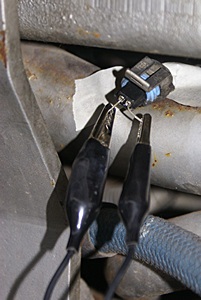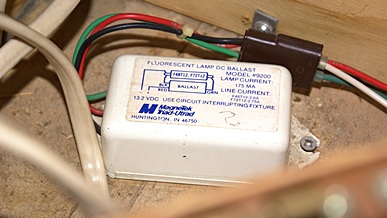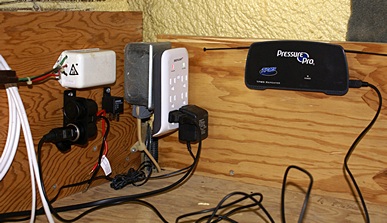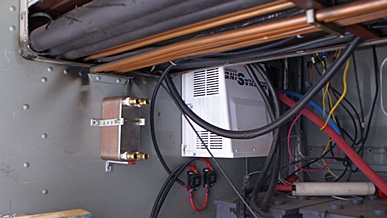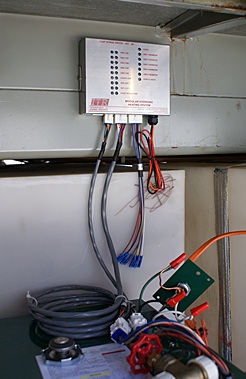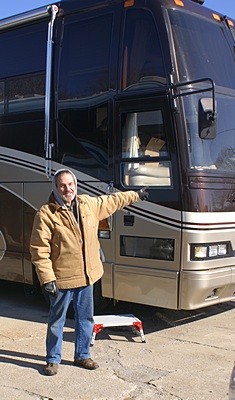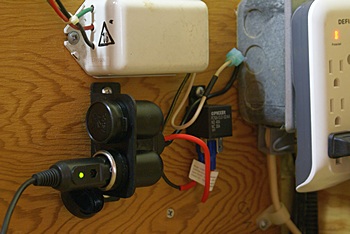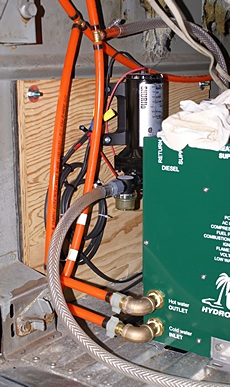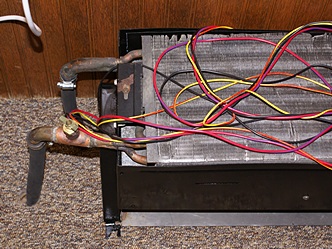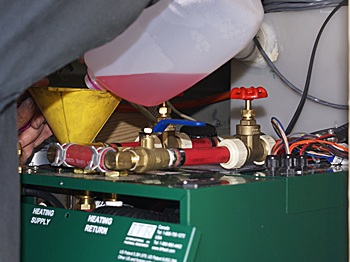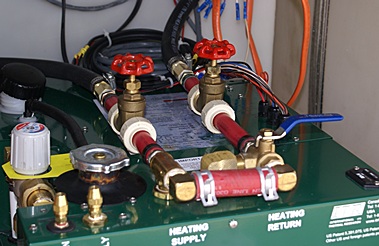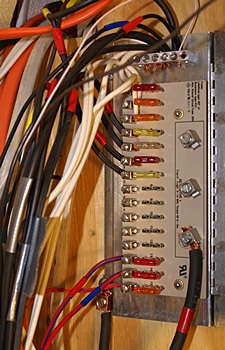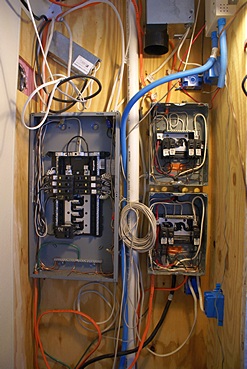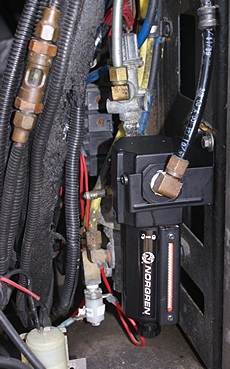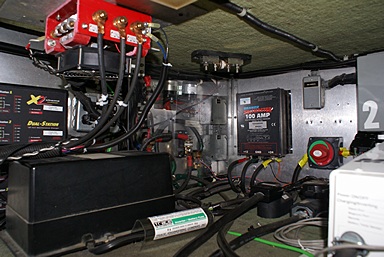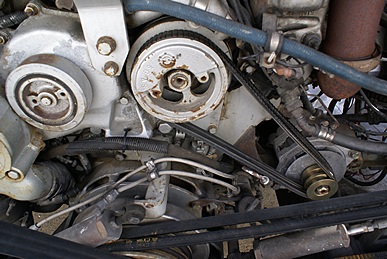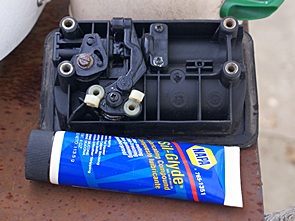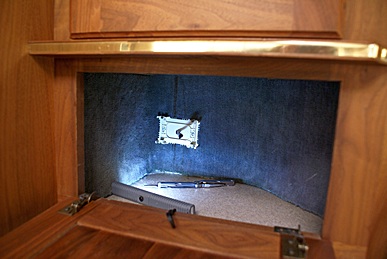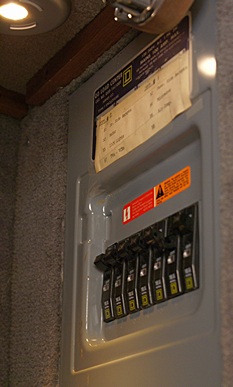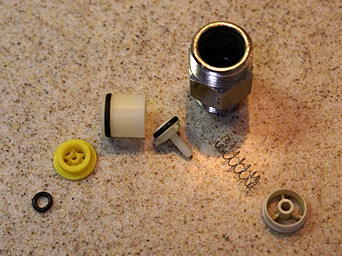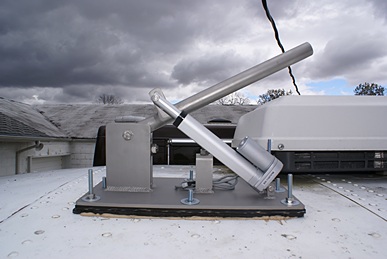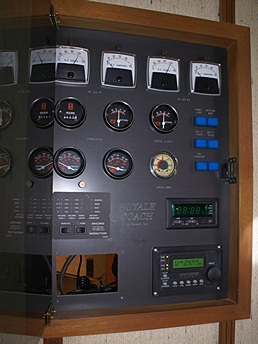2015/01/01 (R) Hola 2015
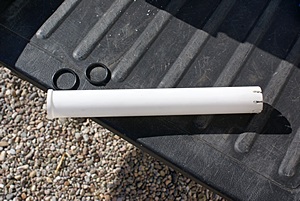
The salt restraining tube for the water filter housing. The slotted end (R) goes down and the o-rings sit in the other end.
Having stayed up later than usual last night to see the old year out and welcome the new year in we were in no hurry to get up this morning, especially given that the temperature outside was in the upper 20s. But Linda said she would make her yummy vegan cinnamon rolls for breakfast so I felt obligated to get up and eat them. Besides, it’s my job to make the coffee. The rolls took quite a while to make and we ended up having them for brunch, but they were worth the wait.
I spent much of the morning looking for new games in the iStore. I downloaded a dozen free ones and then started trying them in turn. Most of them immediately tried to sell me a full version or ran a full-screen advertisement each time I tried to start a new round of play. If they did that I immediately deleted the app. I cannot imagine what makes a game developer think someone with tolerate that more than once. At some point I realized that my AppleID was still associated with an old e-mail address so I initiated the process of changing it. The process was not as seamless as I thought it could/would/should be, but I eventually got it sorted out. Or as they say or Doc Martin, “sorted.” As it turned out my credit card information was also out of date so I updated that as well. Obviously I do not make iStore purchases very often.
I needed to regenerate our portable water softener even though it was 48 degrees F outside in the shade. It was, however, comfortable enough in the sun to be able to work. I started at noon cutting the plastic drain pipe that I bought at Herb’s Hardware the other day to a length of 10″ which is the length of a standard water filter. I cut eight 3/8″ slots in the bottom end of the tube and got an O-ring from Butch to fit in the swaged upper end. The purpose of the tube is to hold salt so that incoming water is required to pass through it to get to the softener but the salt crystals cannot actually wash into the softener.
Linda helped me transfer the contents of a 40 pound bag of solar salt to several two-gallon zip lock bags. I then put a small quantity of salt in a one-quart zip lock bag and gently smashed it with a two-pound sledgehammer, although as I write that it seems to be something of an oxymoron. I inserted the tube into the removable filter housing, slotted side down, and poured the salt around the outside of the tube. I smashed a second bag of salt and added it to the housing. I put the housing back on the filter head and slowly ran water through the softener for almost two hours. I got a water hardness test strip from Butch and tested the output of the softener. It was still showing 7 grains of hardness, exactly the same as two days ago. It appeared that the regeneration process had not had any effect. Bummer.
I discussed the situation with Butch and he suggested I back flush the softener. To do that I needed a hose with female hose fittings on each end. This is the kind of hose used to hook up a washing machine but neither one of us had one with us. Butch, however, had a female-female adapter which allowed me to connect a male hose end to a male fitting on the outlet of the water softener. (Backflushing literally means running water through the softener in the reverse direction to flush out any debris that may after gotten in through the normal inlet.)
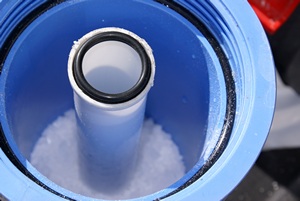
The salt retaining tube in the filter housing with salt around the bottom outside and the o-ring visible at the top.
After backflushing the softener I tried regenerating it again. This time I used a 26 ounces of fine grain non-iodized table salt. With my homemade diverter tube still in place I added the salt around the outside and screwed the housing back on. I let the salt sit in the housing for 20 minutes to start to make a brine and then ran water through the softener until I got a very salty taste at the output. I then shut the outlet valve and let it sit for 20 minutes. When the time elapsed I ran water through the softener for another 15 seconds, checked it for saltiness, and shut the outlet valve. At the end of another 20 minutes I ran water through it at a very slow rate for 20 minutes and then checked it again for salty taste. It was still slightly salty and as it was getting close to sunset I decided to let it sit overnight. I will finish flushing it tomorrow and check the hardness again.
While I was fussing with our water softener Butch recharged theirs in about 30 minutes. When he tested the water at the end it indicated zero (0) grains of hardness; completely softened. Their softener is different from ours and the regeneration procedure is very straightforward and apparently works. For now I need to figure out a guaranteed procedure for regenerating ours, but long-term I need to figure out some other arrangement of just get a different softener.
The arrangement I am considering would be in conjunction with redoing the water bay. With a different arrangement of tanks I could create space in the bay for the softener, multiple filter housings, and associated plumbing. I could set up an arrangement that would divert the incoming water (after the first/sediment filter) through a clear filter housing into which I could put the salt. That clear housing/head would be permanently modified to force water through the salt and allow me to see when the salt was gone. It would also eliminate the need to remove and reinstall the filter the way I have to now. Alternatively I could put a tank between the filter housing and the softener (instead of the clear housing) and use it as a brine tank. If the tank was big enough to hold a 40 pound bag of solar salt it would work just like a home softening system. Water would sit in the tank with the salt for days so that the brine was ready to use when it was time to regenerate the softener. I could even rig up a separate pump just for pumping the brine into the softener. I’m going to give this a lot of thought before I start changing things around, but last winter in Florida and this winter in Quartzsite have made it very clear that hard water is a problem and we need a very effective and efficient way to deal with it.
While I worked with the water softener Linda began preparing a Tex-Mex bean soup for dinner and then went for a long walk. She finished making the soup when she got back while I took a short nap. It cooled off quickly as the sun set and nothing is quite as satisfying on a cool evening as hearty, hot soup. It also had a bit of red pepper heat which was a nice bonus. It was really good soup.
I had a few e-mails from Gary at BCM and a nice follow-up e-mail from Kathy at the Michigan Assessment Consortium. She attached a copy of their holiday letter so I attached a copy of ours in reply. I spent a little time browsing websites for OTA TV antennas and turbo boost gauges and finally went to bed without resolving what to do about either thing. I have a lot of nights that end like that.
2015/01/02 (F) Crazy Days In Q
The “show” at Desert Gardens officially opened yesterday and runs through the end of February, so Quartzsite is quickly be transformed into a crazy place. We were chatting with Butch, Fonda, Jim, and Barb after breakfast and Barb reminded us that starting now driving and parking “downtown”, and especially along Kuehn Street south of I-10, during the day will be difficult to impossible. She offered to drive us down in the golf cart and come pick us up if we did not want to walk. She also told us that many vendors will hold purchases for pickup at the end of the day. We exchanged cell phone numbers, which we had not yet done since they arrived. She suggested that if we wanted to eat out we should go early or right before closing as we might not be able to get seated/served otherwise. There’s no doubt that we have lucked out on our arrangements this winter, and the situation just keeps getting better.
Linda was browsing on her iPad and discovered an all vegan grocery store in Rancho Cucamonga, California; the largest all-vegan grocery store in the world. I looked up Rancho Cucamonga on Google Maps and it is located about half way between Los Angeles and San Bernardino. Based on the speeds I like to drive (often just below the speed limit or 68 MPH, whichever is less) it looks like a four hour drive one-way from Q. That’s obviously too far for a regular grocery run, but we might make a day trip in that direction sometime this winter and find the store while we are over there.
One of the things I did after climbing in bed last night was spend a little time looking at the Sure Marine Service website. SMS is a major supplier of repair parts for Webasto diesel-fired hydronic systems headquartered in Seattle, Washington. After studying their parts diagrams I became unclear (and concerned) as to whether the burner we removed from Butch’s old unit was a DBW2010 or a DBW2020. They are very similar but not identical. I am almost certain that our original burner is a DBW2010, but our AHU-xxx Aqua-Hot is so old that the model number is no longer referenced on the website and model specific documentation, like a service manual, is not available for download.
The reason I was looking at the parts diagrams was to identify the bearing kit for the blower as I wanted to order two of them today. What I could tell from the website was that the 2020 is a higher BTU output burner and so one of the differences is that the 2010 uses a 0.35 GPH nozzle while the 2020 uses a 0.60 GPH nozzle. That alone might account for why we seem to have poor combustion, although even money is still on bad bearings. The unresolved issues and the inability to investigate at midnight did not make for a good night’s sleep.
I have the Aqua-Hot service/repair manual for the unit I bought from Butch, both on paper and on my iPad, so I spent some time this morning looking at the iPad version. I could not tell if they used the same bearing parts so I did not order anything today and won’t until I can determine model numbers. I asked Butch if he knew which burner was in the Aqua-Hot I bought from him, but he did not. The service manual shows a Webasto label that identifies the burner model, but does not show where the label is located. More investigation was needed.
After I got dressed I e-mailed Bill Gerrie (RetiredBusNut) in Ontario, Canada with questions about gauges and sending units for our bus engine and transmission. I then started dealing with the water softener. Linda returned from her walk and started preparing lunch, so I emptied the filter housing of the little bit of salt that was still in the bottom, rinsed it clean, re-installed the filter, and let it run for 20 minutes to fully flush out any residual salt water.
Linda made a warm garbanzo bean and kale salad for lunch with lemon juice and garlic. It was the first time she had tried this recipe and we both agreed it was a keeper. After lunch I tested the hardness of the water coming out of the softener and it registered on the test strip between zero (completely soft) and 1.5 (definitely soft) so I dumped the remaining (hard) water in the fresh water tank and refilled it with 120 gallons of nice, soft water. After the tank was full I retested the water coming out of the softener and got the same reading as before. Finally, some good news on the water softener front.
With water softening taken care of (for now) I did an online search for a panoramic camera tripod head. I really like shooting panoramas and the Microsoft Image Composite Editor (MS-ICE) does a remarkable job stitching images together. Most of my panoramas have been handheld, which makes the performance of MS-ICE all the more impressive. I have shot a few panoramas using a tripod but without a nodal point (spherical) pan head, so that is what I was searching for online. B&H Photo had a Manfrotto on sale for $280, marked down from $600, but their order desk was closing for the day and I did not want to be rushed making this decision so I did not order it. They will reopen tomorrow, so I will think about it overnight and do some more research.
I got our old Webasto burner out of the front bay and found the label. It is, indeed, a DBW2010, specifically a DBW2010.75 with a 0.35 GPH nozzle rated at 45,000 BTU. Linda recorded the details, including the serial number, and then helped me rewrap it in bubble wrap so I could put back in its storage pail.
Linda then went to Parker, Arizona with Butch and Fonda to check out the Safeway grocery store and look for some things at Walmart. The Parker Safeway was supposed to carry Daiya vegan cheese products but they were nowhere to be found. It appears that our closest source will be Whole Foods. There are five of them in the greater Phoenix area but that is a two hour drive one way.
While the three amigos were gone I removed the cover from the Aqua-Hot in our coach and found its label. Much to my relief it is also a Webasto DBW2010.75, 45,000 BTU. It should also have a 0.35 GPH nozzle, and probably does, but I did not pull the burner out to check. I noticed some soot on the final fuel filter inside the housing and in other places so that gave me something new to be concerned about. I was pondering the situation when Jim and Barb and Roho came over to visit and we had a good long chat. When they went back to their motorhome I put the cover back on the Aqua-Hot and put all of my tools away.
My plan for tomorrow is to turn the Aqua-Hot off, let it cool down, and pull the burner to check the nozzle. It’s possible, though not likely, that I do not have the burner seated quite right and there’s a chance, though very small, that reinstalling it will fix, or least improve the performance. My money (literally) is still on the blower bearings. Hopefully it does not also need a new motor as everything on a Webasto is more expensive than seems reasonable. It’s another fine example of precision German engineering and manufacturing.
Even though I have quite a few e-mail addresses that I use to segregate electronic correspondence into manageable categories my inboxes still end up flooded with e-mails. Very few of them are spam—we have good spam filtering on all of the accounts—but some of the highest volume inbound traffic is notifications of things like failed login attempts on WordPress websites. Those e-mails do not get replies and often do not require any specific action on my part, but they sometimes obscure the presence of other e-mails that do require my attention.
Microsoft Outlook is able to deal with incoming (and outgoing) e-mails based on user-defined “rules” but I had never played with that feature until today. I used the online help system to read about the whys and wherefores of e-mail rules and then tried creating some. Once I understood what I was trying to accomplish it was mostly point and click to get it done, with a little typing thrown in. What I ended up doing was creating sender/subject subfolders under the inbox of certain accounts and then creating a rule for each subfolder that directs incoming e-mails matching the criteria to the correct folder. By keeping the sub folders under the inbox folder it will be clear to me that these are e-mails that I have received but not yet dealt with.
For dinner Linda made a cooked shredded Brussels’ Sprouts dish with tomatoes, dried cranberries, and pistachios and served it alongside the leftover Mexican rice with a glass of sangria. Ole! We agreed that both of these dishes were keepers and went well with the fruity wine. The rest of the evening was quiet. Linda read and played her online games while I finished up working on this post. I finally went to bed and started reading the service and repair manuals for the Aqua-Hot system and the Webasto burner. According to the long-term weather forecast tonight should be our last night with an overnight low temperature below freezing.
2015/01/03 (S) Hammer Stahl
I got up at 6:30 AM today. I had been awake for a while before that and had some things I needed/wanted to do on my computer. These were quiet tasks that I could do in the front of the coach, with the heat turned up, without disturbing Linda.
I always check my e-mail first. There was a group message from Hillary at RVillage to all of the Ambassadors regarding a new feature they will be rolling out soon and seeking our assistance. I mentioned this to Linda when she got up and we watched the two YouTube videos. We did not have time today but will work on it tomorrow in advance of a 5 PM (4 PM PST) web meeting.
My first project today was updating the spreadsheet I maintain for our FMCA Freethinkers Chapter, which I started working on last night. The chapter treasurer maintains our checking account but as the secretary I maintain the records including the roster and who has paid their dues for what years. Because I have all of those details I also generate the quarterly and annual financial statements. I entered the information for dues payments that had been received between November 1 and December 31. I then added the five worksheets for 2015 (four quarters and year), which tie together and link back to the 2014 statement, and updated the cumulative financial statement.
Linda got up so I put my work aside to make coffee while she made breakfast. We had a few bananas that were ripe so she made green smoothies for breakfast. We happen to like kale but if we didn’t, green smoothies would be an excellent way to get our daily dose along with several other healthy ingredients.
We talked about visiting the market area today and decided to go later when it was a bit warmer. The temperature a 9AM was still only 40 degrees F so Linda bundled up and went for her morning walk while I continued to work on my spreadsheet.
Once I finished the spreadsheet I worked outside for a bit. I removed the cover from the burner end of the Aqua-Hot while it was running to check for an exhaust leak (sight, smell, touch) but I could not detect one. When the cycle finished I turned the burner off. My plan was to let the unit cool off and then remove the burner to check the nozzle size and do a general inspection of the combustion chamber and visible parts, but that did not happen today.
What I did instead was return to my computer and start putting Webasto repair parts in my shopping cart on the Sure Marine Service website. The bearings on the installed burner are definitely whining and need to be replaced. They are supposed to be replaced regularly anyway, so I put two sets in the cart. It is very likely that they are causing the motor to run slow which means insufficient combustion air, and possibly lower fuel pressure, leading to the dark smoky exhaust. I also put a fuel solenoid valve in the cart. There is a good chance that the valve and/or the solenoid are not working on the other burner. There’s also a chance that the ignition coil has failed, but the solenoid valve costs 1/2 as much as the coil, so I’m hoping it’s the valve. I got the order submitted with UPS ground shipping and used PayPal to make the payment.
Once I completed the SMS order I loaded the B&H Photo app onto my iPad and spent quite a bit of time going between their website and the Sony online store trying to figure out if I should order a panoramic tripod head and/or new camera, possibly with a lens and flash unit. Sony has the Alpha 99 FF body marked down from $2,800 to $1,900 with the vertical grip and an extra battery thrown into the deal, an additional $500+ value. They will also bundle in the SAM 28-75mm f/2.8 lens for $400. The lens by itself is normally $900, so that’s another $500 savings.
So for $2,500 I could get $4,200 worth of Sony’s top-of-the-line “flagship” DSLR (DSLT, actually) equipment, except for one thing; it was all on back order with an ESTIMATED ship date of February 4, 2015. That’s my birthday, so if it actually shipped on that date it would be quite the birthday present, but if it was delayed very much there would be the very real possibility of it arriving at our location in Q after we had left. Not good.
So what about B&H Photo? It turns out that they (claim to) have all of these pieces in stock and they are selling the body with the added pieces for the same price as Sony, but they are not offering the lens at the bundled price. That was the deal breaker that saved me spending a lot of money today. Besides, I have been waiting a long time for Sony to officially announce and the ship the new (rumored) flagship alpha a99-II with its 36MP FF 35mm sensor and long list of awesome features. To decide now to by prior generation technology it would have to be a very attractive deal, much better than what I was seeing online.
I ended up ordering a Manfrotto Nodal Point Pro panoramic tripod mount from B&H. It should be here by the end of the week. When it arrives I think we will hike up to the top of “Q Mountain” and try to capture the true essence of Quartzsite in the winter, which is RVs from horizon to horizon.
We headed down to the market area on Kuehn Street with Butch and Fonda and walked around for a couple of hours in the Tyson Wells Show grounds north of Kuehn Street and west of Central Avenue (US-95). This particular market area had really filled up with vendors in the last few days. Linda bought a nice white apron and really nice Hammer Stahl 5.5″ Santoku knife. She checked online when we got back and she paid about 55% of the MSRP on the HS website. She bought it from Cutlery by LeClaire, which also has a website, and has it on sale for $20 more than the price on the HS website, marked down $20 from their “regular” price. The point is, she got it for what appears to be a good price of $59 and it came in a nice box with a ceramic sharpener thrown into the deal.
We drove farther west on Kuehn Street and pulled into the Desert Gardens show grounds. It was getting near sunset, so we did not stay long, but Linda and I walked enough of it to get a feeling for the place. It was a “rougher” setup than Tyson Wells and many of the booths were selling large, rough rocks and gemstones. The vendors also had a lot more equipment set up and were using it to process materials. We’ll be back, probably more than once, and earlier in the day so we can spend more time.
When we got back to our motorcoaches Fonda came over and worked with Linda for a little while on their business records. We then had a nice salad and some of the spicy bean and pasta soup (that Linda made the other day) with crackers and sangria. I spent more time after dinner researching stuff on my iPad and working on this post.
We appear to be in one of the few places in the country that is not getting clobbered by bad weather. The temperature is not even supposed to drop below freezing overnight. It will still be cool tomorrow, however, and we did make specific plans before going to bed.
2015/01/04 (N) Our Village
We had vegan pancakes for breakfast which prompted me to suggest that Linda invent some recipes, even if they are interesting and successful variations on existing ones, and feed them to our grand-daughter. Linda could put them on our website using the WP Ultimate Recipe plug-in and, if they met with her approval, name they after “Bitty” (youngest grand-daughter’s latest nickname, although I think I will always prefer “Schmoo”). Perhaps Pancakes Madeline; Sautéed greens a la Madeline; Pasta Madeline; or Madeline’s vegan mac and cheese. Being retired gives me a lot of time to think.
Joe’s brother, Jim L., finally returned from Nevada today and was able to get the park model trailer unlocked. Barb has been wanting to get in and clean it since she and Jim (different Jim) arrived. Barb is a keep busy kind of gal. She is responsible for maintaining the apartment and laundry room while she is here and told Connie she would also do some deep cleaning on their house trailer, so it’s been bugging her that she could not get in to do it. As for my part, all I did was lock the door on the trailer the way Connie asked me to. Barb and Jim (husband) had lots of keys but could not get any of them to work.
Today was shower day. This is always more of a production than we would like because we keep the cats’ litter tray in the shower. Most of the time that works really well—it is out of the way and contains any mess they might make—but it is inconvenient when we want to use the shower for its intended purpose. Besides pulling the tray out into the hall by the bathroom door we have to clean up any stray litter in the shower to make sure it does not end up in the gray water waste tank. Litter tray or not we still have to spray the shower walls when we are done, squeegee off the glass door, let everything dry, and then reassemble it as a giant cat litter box. But it works and it’s one of the compromises we willingly make to live with our cats in so few square feet.
Once I was dressed I went outside to chat with Jim L. (Joe’s brother) and we discussed the possibility of upgrading the electrical service at our site to “50 Amp” (240VAC, 50A, 4-wire, the equivalent of a 120VAC, 100A residential service). It’s not an issue for us right now as the cool weather has us burning diesel fuel to make space heat, but once the weather turns warm we may need our air-conditioners. We have three but can only run one on a “30A” service and still have enough power to run other things. A 30A service is just what it says; 30A of current at 120VAC. A “50A” RV service is slightly more than three times that amount of power.
The electrical hookups here are very interesting. Perhaps all RV park power pedestals work the same way, but I have never looked inside one so I don’t know. The meter is at the top and the area below it has a top-hinged cover. Under the cover are three panels about 3″ wide and 15″ tall. The panels have an outlet towards the bottom and a circuit breaker near the midpoint. Behind the panels are busses for the hot, neutral and ground with male blade connectors. The panels have female blade connectors that engage their male counterparts when the panel is slipped and then hinged into place. It is secured with a single screw. If Jim L. can find a 50A panel all we will have to do is unscrew and remove the 30A panel and plug in the new one, once we verify that 240 VAC (L1& L2) are present in the box and wired to the distribution busses.
Instead of her usual morning walk Linda setup her laptop on the dinette table and worked on accounting and tax issues for Butch and Fonda. I set my laptop there as well to work on the roster for our FMCA Freethinkers Chapter and Jasper got in between us, so we had a nice, cozy computing session. When I placed my order with B&H Photo yesterday I checked a box to receive shipping status information via TXT message. I got one this morning letting me know that my package had shipped from NYC. Cool.
With accounting chores done for now Linda prepared vegan hot dogs with mustard, onion, and relish for lunch. She then went for a long walk while I stayed at the coach and worked with a new feature on the RVillage website. I was posting a lot of suggestions to the topic thread on the Ambassador forum and got a phone call from Curtis, the founder/CEO of RVillage. We had a long chat and I was still on the phone with him when Linda got back. I worked with the website some more and at 5:00 PM we connected to an Ambassador meeting using GoToMeeting on my computer. This is a very exciting new feature and I think RVillagers and RV-related businesses are really going to like it once they know about it and see how it works.
Linda made mock (vegan) stroganoff for dinner. She normally uses Basmati but the only rice she had enough of was Texmati so she used that. Although I did not care for the texture of the Texmati in this dish (a bit crunchy), the taste was still very good. This dish requires real cooking, which means it makes a real mess. By the time everything was cleaned up and put away it was 8 PM and we were both tired. I continued to research engine and transmission gauges while Linda read and played word games. I also revisited the SonyAlphaRumors website but there was absolutely NO new information on the a99-II. I went to bed wondering if this camera will ever actually exist. Based on the comments I see online I am not the only one wondering if this camera will ever be a reality.
2015/01/05 (M) VSWR 1.0
Yesterday we finished up the coffees we have been using since we left Michigan at the end of November so this morning I had to open new bags and transfer the contents from their vacuum sealed bags to our metal storage canisters. I had Teeko’s roast Ethiopian Yirgacheffe regular and decaffeinated separately, so I opened 1/2 pound bags of each. I also opened a 1/2 pound bag of our special Sweet Seattle Dreams, which is 1/2 Sweet Dreams (decaf) and 1/2 Seattle Blend (regular). I then made a pot of Ethiopian Yirgacheffe 1/2-n-1/2 while Linda prepared our granola with fresh bananas and fresh blueberries.
Linda went for her morning walk while I continued to do online research regarding the enigma known as the Sony a99-II DSLT camera and the supposedly discontinued, but apparently still very much available, Sony alpha a99. If I did not already have a nice assortment of compatible Minolta A-mount lenses and flash equipment I think I would stop wasting my time with Sony cameras. But I do, and so I continue to wait and be frustrated along with thousands of other “enthusiast” (sub-professional) photographers. Because Sony builds the image stabilization (anti-shake) feature into the alpha bodies instead of the A-mount lenses the feature is available even with older Minolta lenses and the new lenses are slightly less complicated and less expensive than the Nikon and Canon lenses, which have the image stabilization built into each lens. I think this was one of Sony’s best innovations.
I also continued to look at automotive gauges and sending units and decided to call Bill Gerrie (in Ontario, Canada) to follow up on his reply to an e-mail I sent a few days ago. We had a great chat and he was able to clarify some things and add quite a bit of specificity to his written reply. As a result I have a pretty good idea of what I am looking for; now it’s just a matter of finding it and deciding to place the order.
I was starting to work at my computer when Linda returned from her walk. She eventually fixed a couple of vegan hot dogs wrapped up in tortillas with mustard, onions, and relish. As I was finishing my meal I got a call from Gary Hatt at BCM. He recently acquired an Eagle bus conversion and had some questions about the air-conditioners and the Aqua-Hot. He plans to be in Quartzsite next to week and we are looking forward to finally meeting in person since I have been writing articles for the magazine for almost two years.
Linda has been having a problem with the brightness (or lack thereof) of the touch screen on her 19 month old Windows 8.1 Samsung laptop. It will go very dim for no apparent reason and cannot be adjusted. There was a driver update available for the Intel HD Graphics processor so we downloaded it, installed it, and re-started her computer. The screen was now bright, which was more useful than dim, but still not adjustable. That could be a coincidence or a fix, we will have to wait and see. Even though it was working (for now) I drove to the local Family Dollar and bought an HDMI cable and some lightly carbonated water. (The water had nothing to do with Linda’s laptop computer display, we were just low on sparkling water.) The cable will allow us to connect her computer to one of our two flat panel LCD (LED) TV/monitors if needed. (We did that after dinner and it worked, mirroring the built-in display to the monitor and setting the resolution to match the monitor’s 1900x1080p native mode. But it also caused the built-in monitor to dim, although not as much as before. When we turned off the monitor and unplugged it the built-in display did not return to full brightness.)
Mid-afternoon I saw Butch working on his Tarheel screwdriver antenna so I inquired as to what he was doing. He had connected his MFJ VSWR meter to it through a six foot length of coax. He had also unplugged the control harness for the tuning motor and rigged up a temporary switch to extend and retract the antenna. He had done this because he was getting meter readings when connected through the installed coax that indicated the antenna was not resonant at any frequency or that the meter was not working correctly. I climbed up on his ladder to have a look and saw VSWRs that were often greater than 31:1, and never fell below 10:1, with complex impedances that were rarely 50 ohms and with both resistance and reactance values that were all over the place. Clearly something was not right. It was not his installed coax and I was fairly certain I was not his meter, which I had used back at their house to check the VSWR on his CB and 2m ham antennas.
I climbed onto the roof of their bus so it would be easier to reach things and I could work sitting down. We tried adding a ground strap as a counterpoise but it didn’t help. Butch then grounded the strap to the chassis at the motor but that did not help either. Our concern was that the antenna was not sufficiently bonded (grounded) to the roof but nothing we tried made any difference. I decided to set the antenna to its shortest length (highest operating frequency), set the meter to a lower frequency, and then slowly lengthen the antenna, thereby lowering the operating frequency, while looking for some sort of response on the meter.
I got no change on the meter and finally realized that the antenna (via the meter) was behaving as though it was not grounded. I noticed what looked like a thick washer between the SO-239 antenna connector and the base mounting plate of the antenna. The mounting plate is the ground reference for the antenna and is connected to the base of the antenna through a coil of insulated wire (an inductor) known as a base loading coil. The spacer was a plastic insulator that was, indeed, preventing the case of the SO-239 antenna socket from making contact with the mounting plate. As a result the antenna was not grounded through the coax cable shield, preventing the meter from obtaining meaningful readings.
We removed the antenna connector, removed the insulated spacer, reassembled the connector to the antenna, reattached the coax and meter, and took additional measurements. This time we got excellent readings that made very good sense. We checked the upper bound, lower bound, and the midpoint of most of the high frequency (HF) ham bands and were always able to obtain VSWRs of 1.3:1 or less, which was excellent. Butch had been considering redoing the mounting of the large motorized fold-over base so it was a good thing we figured this out as it saved him a lot of unnecessary work. If I can solve one problem without creating others I figure it’s a good day. BTW: VSWR stands for Voltage Standing Wave Ratio and 1.0 is not a beta version, it is shorthand for a ratio of one-to-one (1:1), which is the best SWR you can have. Anything below 1.5:1 is considered excellent, below 2.0:1 good, and below 3.0:1 usable if that’s the best you can do.
Chayote is a fruit that is a member of the squash family and is related to other gourds such as melons and cucumbers. Linda bought one last week when we went to Albertson’s grocery store in Blythe, California and decided to prepare it for dinner tonight. She sliced it into long thin broad strips and sautéed them with onions, oregano, salt, and pepper. She served it alongside the leftover mock (vegan) stroganoff with a glass of sangria. Our wine friends can cringe all they want; we find the Vella and Franzia boxed wines generally agreeable and the sangrias go surprisingly well with a variety of dishes. And it has me drinking red wine, so it’s healthy too!
We lost our WiFi connection this evening. Not sure why. The wireless gateway still shows up in the WFR list but won’t associate with the WFR. Butch had the same problem at the same time so something obviously changed. We will ask Barb to open the trailer tomorrow, or get Jim to do it if she is not comfortable, so we can reset the gateway. Hopefully that will do the trick.
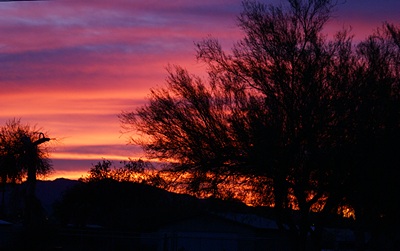
The sunsets in Quartzsite are amazing almost every night. This shot was taken from our campsite in Q.
2015/01/06 (T) You’ve Got Mail (Maybe)
Our mail situation here is interesting. Remember that, per our Jamaican tour guide, we do not have problems, only situations, and situations are easier to deal with if I regard them as interesting rather than annoying. With regards to receiving mail, the “situation” is as follows. Although every structure in town has a street address—necessary for police, fire, EMS, trash collection, and other municipal services—the Quartzsite post office does not deliver mail to said locations. They have an annex building on the northeast side of town that is nothing but P. O. boxes and all of the locals, and a lot of seasonal residents (including Joe and Connie, who own the property where we are staying) have a P. O. Box.
Where things get interesting is that the main post office and the street addresses are associated with one ZIP code but the P. O. boxes have a different ZIP code. If something is coming to us via UPS or FEDEX we have to use the street address and associated ZIP code, but if it is being mailed to us USPS we have to use the P. O. Box number and associated ZIP code, or have it sent c/o General Delivery using the main ZIP code. To confuse matters further, Joe and Connie had to return to Nevada because of Joe’s health and are having their Quartzsite mail forwarded back to their home, so we cannot have mail sent to us “care of” them as we originally planned as it just gets forwarded to Nevada. Outbound mail does not appear to be a problem, but then why would it be?
The other situation that developed yesterday was that our WiFiRanger Mobile Ti disconnected from Joe and Connie’s WiFi (DSL) gateway and would not reconnect. The WFR is telling us that the WPA password may be incorrect, but that is unlikely as we have been using it since we arrived last month, as have Butch and Fonda who also lost their connection yesterday and could not reestablish it. The evidence suggests that the gateway needs to be reset. Why? Who knows? DSL gremlins perhaps. Or mischievous Internet fairies. Or a problem with the local DSL service? Or perhaps Butch keyed up his 600 Watt linear HF ham radio amplifier and blew out every wireless DSL router within a quarter mile? Whatever the cause, once we can get Barb or (brother) Jim to open the trailer we will power cycle the gateway and see if that restores our ability to connect to it.
In the meantime, in order to get online last night and again this morning, we turned on our Verizon MiFi. The Verizon signal here is strong and steady, and the data rate is much faster than the DSL/WiFi connection, but we only have a 4 GB data plan so we tend to use WiFi when available. It is not always available, of course, especially while traveling (and especially if we are boondocking at Wally World or other such locations) and when it is available it is not always reliable or is so slow as to be useless. This can be the situation, for instance, at larger RV rallies and even some RV parks.
So we logged into our Verizon Wireless account, looked at our current plan, and saw that for a mere $10 more per month we could increase our data plan from 4 GB to 10 GB. The cost for exceeding your monthly data plan limit is $15/GB, so the extra $10/month was a no-brainer. And VZW made it soooo easy to change our plan (once we were logged in); just click the data plan we want, review changes to our account, and click “Apply Changes.” Done; they have our money and we have more data allocation. Interestingly, they upped our data allocation immediately for the current billing cycle, which is Dec 20 – Jan 19, and added the $10 to the bill we will receive for that cycle. No pro-rating going on here, but then we can use the whole 10 GB if we want/need to.
Interestingly the cost to go from 10 GB to 15 GB was an additional $20/month, so the 10 GB plan seems to be a sweet spot after which you pay a premium for additional access. On the one hand Verizon wants to sell you data bandwidth but on the other hand there is a finite amount of data they can move through their network, so if you want to use a larger chunk of their capacity it figures that it would come with premium pricing.
Until a few months ago Millenicom was reselling 20 GB MiFi plans (on Verizon’s network) for $70. It was the best deal around; a sufficient amount of data for the same price we were paying Verizon for only 4 GB. Kind of unfair, when I think about it. Well, Verizon decided to stop selling bulk capacity to Millenicom (and other MVNAs?), took all of the accounts in-house, and Millenicom went out of business. Not really a big surprise when you think about it. Verizon also notified those customers (as I understand the situation) of their “options” which were not, apparently, as attractive as the deal they had with Millenicom. Not really a big surprise when you think about it.
Anyway, we will see how we do with 10 GB/month while we are on the road. We can change back to our 4GB plan when we get home, but I doubt that we will, and we can increase it to 15, 20, or even more GB per billing cycle if we need to, but that is unlikely. We have an AT&T landline at home with DSL service that provides an “always on” Internet connection (when it works). It has a 150 GB/month data allowance and allows us to monitor and control our whole house generator and WiFi thermostat. We have discussed adding a security system and a personal weather station linked in to Weather Underground’s Wundermap when we get home. I don’t think our DSL connection is fast enough, however, that we could use 150 GB in a month if we tried.
Linda went for her morning walk and I made a quick run to Barry’s Breads. Barry is a really nice older gentleman who has a small bakery stand on the north side of Kuehn Street east of Central Avenue. Just behind the stand, however, is a larger trailer in which he bakes all of his products. Those products include breads, rolls, savory items, and sweet goods. Most of his products use butter, cream cheese, cheddar cheese, or ranch dressing, but his Basic Bread is just that, flour, water, sugar, salt, and yeast. I have had some difficulty figuring out what time of day to stop by but this morning he finally had loaves of bread, and some hamburger buns made from the same recipe, so I bought a loaf and a pack of four buns.
When I got back I started working on another article for Bus Conversion Magazine. A little over a year ago I installed an RV-Critter Guard to seal around the shorepower cord and water hose where they enter the utility bay through the floor. I took a few pictures during the installation and have had the article on my “future” list ever since. By the time Linda got back from her walk I had the article mostly finished and was starting to look at the photographs.
She had stopped at the Salvation Army store, which was open, to use their facilities and ended up buying a grocery bag full of clothes for $1. Not $1/item, $1 for the entire bag. Most of the items were tagged with color codes indicating prices of one or more dollars each but they had too much inventory and needed to move some product. They told Linda that when that happens they have their $1 bag sale. Deal. She called Butch and Fonda to let them know and I think they headed there before going to check the post office box and then stop at the post office if needed.
Linda cooked a couple of our Boca vegan mock hamburger patties and served them with fresh sliced onion, lettuce, and pickles on two of the buns I had just purchased. Not an entirely WFPB meal, but very few of our meals are. Still, we try to get as much plant-based whole foods as we can every day.
Linda went for a second walk after lunch and headed down Central Avenue towards the Kuehn Street markets. She is so fond of her 5.5″ Hammer Stahl Santoku knife that she wanted to buy the 3.5″ paring knife if Cutlery by LeClaire had it for sale as an individual item.
While Linda was gone I finished working on the photos for my RV-Critter Guard article. When she returned from her walk she had both the Hammer Stahl 3.5″ Paring Knife AND the 3.0″ Birdsbeak Paring Knife. As we learned the other day from an Alton Brown video paring is actually a technique in which food is held in one hand and a knife in the other; no cutting board is involved. Paring knives are generally smaller with a shorter blade and most of the weight is in the handle, allowing very fine control of the cutting edge and tip.
The Birdsbeak is a particularly interesting and unusual knife. The bottom/cutting edge is slightly concave rather than convex like the classic chef knife. The bottom edge joins the top edge in a point with a shape that resembles certain types of curved bird beaks. In use, the knife is often held stationary and the food is pressed or turned into it, such as decorative peeling, pitting of fruit, or slicing strawberries. Linda is often reluctant to spend money on herself so I think it’s nice that she found something she wanted and made the decision to buy it. Like any high quality tool it will make the work it is designed to do easier and more enjoyable.
While I was uploading my article to our Dropbox Linda went outside to sit. Barb wandered over and I mentioned that the DSL wireless Internet gateway had quit working. She let me in the trailer where I found it sitting on the dining room table. I powered it off, waited 60 seconds, and powered it back on. All of the status lights came back on in the expected sequence and I was once again able to connect our WiFiRanger Mobile Ti to it. We ended up standing by their Country Coach Intrigue motorhome and having a long chat.
Butch and Fonda were gone for most of the afternoon so we only got to chat for a little while when they returned before the sun dropped behind the southwestern mountains and the temperature dropped along with it. Linda and I talked about going out to dinner, which we have only done once since we got here, but she remembered that we had a FedEx package scheduled for delivery today and that it might arrive as late as 8 PM. So we had leftover soup with crackers and sangria. This was the third and final meal we got out of this pot of soup and it was good to the last drop. It was a packaged mix but Linda thinks she can recreate it; getting the spices right will be the tricky part.
After dinner I read DSLR reviews on the Digital Photography Reviews website and continued to look at gauges and sending units for the bus. Around 8:30 PM I was having trouble staying awake but by 9 PM I had gotten my second wind and decided to write another short article for BCM. This one was on the failure of Butch and Fonda’s main engine air-compressor on the drive down, how he dealt with it on the road, and eventually ended up installing a rebuilt one here at our campsite in Quartzsite. I had the article written by 11 PM and decided to work on the photos tomorrow.
2015/01/07 (W) Catch 22
My main pair of reading glasses broke yesterday; not the lenses or the frame, but one of the nose pads. Well, not the actual pad, but the small plate and mounting loop, specifically the mounting loop. I was cleaning them and the whole assembly fell out. The loop was split and had opened up. The loop was a very small and delicate piece of ductile metal so I squeezed it back into a circle. I removed the very tiny retaining screw, reinserted the mounting loop, and put the screw back in. I was able to do this using only the tools available on my Leatherman. The repair did not hold and it fell out again last night. This time a piece of the loop broke off so the only repair will be a new mounting pad if I can find one. There is a Wal-Mart in Parker that probably has an optical shop but I don’t know how universal this mounting system is.
I checked the level of the floor and counter in the kitchen last night and the coach appears to have settled slightly on the driver side. Not a lot, but enough that I can feel it and it registers on the level. I generally have to start the main engine and build up full air pressure in order to level the coach but I thought today would be a good day to finally pull the portable air compressor out of the car and see if the leveling system will work without the main engine running. As it turned out that did not happen today because we ended up driving to Parker, Arizona.
Our destination in Parker was the Wal-Mart. The store did not have an optical department but we found an eyeglass repair kit in the pharmacy area with a pair of screw-in pads and a pair of snap-in pads. They also had a repair kit with a tiny screwdriver, spare screws, and other parts. Between the two kits I was able to install a new pad in the car to replace the broken one. That saved us a trip the optical shop in town.
Parker sits on the Arizona side of the Colorado River which is the boundary with California. We decided to drive across and then take CA-62 over to US-95, follow it south along the River back down to Blythe, and then take I-10 back to Quartzsite. Butch called while we were in Parker to let us know that there was a Farmer’s market at Desert Gardens. It operates on Wednesdays from 8 AM to noon so we did not make it back in time but resolved to go in future weeks.
I worked on my “roadside repair” article for BCM while Linda went for a walk. Jim and Barb had gone to Blythe to buy a new faucet and Jim L. stopped by and helped Jim B. install it. They borrowed a caulk gun from us (we carry two in the bay) but had to go buy caulk. UPS showed up with yet another package for us, after which we had a long conversation about the inadequacies (incompetence) of the U. S. Post Office in Quartzsite. (The UPS driver told me that both UPS and FedEx have extra drivers and trucks delivering into Quartzsite during the peak season. What a novel idea.)
Back to the post office. We are waiting for a shipment of two bottles of water hardness test strips that we ordered through Amazon but were shipped via USPS by a swimming pool supply company in Elkhart, Indiana. I gave them the P. O. Box here in Q since the post office does not deliver mail to street addresses and it appears that they will likely get returned to the sender rather than delivered to us. The root cause of the problem (and it is a problem) is that Joe and Connie are having their mail forwarded to their home in Nevada. If their names are not on the mail the post office won’t put it in the box, but if their names are on the mail it still does not get put in the box, it gets sent to Nevada. So as of now the box is sitting there but cannot be used; a genuine “catch 22.”
Fine, we will just use General Delivery. The problem with that (and it is a problem) is that you can only pick up the GD Mail at the Quartzsite post office between 11AM and 1 PM, and there are untold numbers of people trying to do the same thing. That means ridiculously long lines and ridiculously long waits. Considering that the influx of seasonal “residents” to Quartzsite has been going on for over 30 years the postal “service” has had ample time to figure out how to handle the situation. I mean, Amazon practically runs its holiday operations with seasonal employees, many of whom are RVers. Gee, I wonder if there are any RVers around Quartzsite this time of year. While the post office is trying to figure out how to not deliver our mail we have two more UPS shipments scheduled to arrive on Friday.
Linda made a zoodle dish for dinner. She used her SpiraLife to turn a zucchini into long thin strips which she cut into 6″ lengths and then used like spaghetti in the dish. The other ingredients were onions, garlic, mushrooms, asparagus, and green beans. Everything got sautéed in a pan with a little olive oil, salt, and pepper. We had a glass of Lamb’s Valley Organic Sweet White wine and it was a lovely meal.
After dinner I put the finishing touches on my BCM air-compressor repair article and e-mailed it to Butch to proof-read. The only thing worse than writing an article that makes me look stupid is writing one that makes someone else look stupid, especially a friend.
I had an e-mail from Gary, the publisher of BCM, letting me know that the December 2014 issue was finally available online. I downloaded both the SD and the HD versions. I then clipped the cover from the SD version, pasted it into MS Paint, and saved it as a JPEG file. I opened it in Faststone Image Viewer, resized it to a thumbnail, and sharpened it. I then edited the BCM page on our website, adding the thumbnail image, the title of my article, and a brief description. I have a similar entry on that page for every issue in which I gave had an article, starting with the February 2013 issue. The December 2014 article was my 14th in 23 months.
